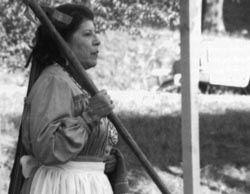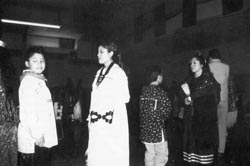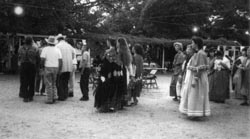Caddo Homecoming
By Dayna Bowker Lee
The Caddo people still come home to Louisiana to visit the places they "remember," though they haven't lived here since 1835. This is not to say that all historic Caddoan bands originated within the present political boundaries of the state of Louisiana, but that the Caddo trace their origins to the middle-Red River Valley in northwestern Louisiana and southwestern Arkansas, once part of the vast Louisiana territory claimed by France, Spain, and the United States.

According to traditional history the Caddo entered this world near Caddo Lake, emerging through a cave in a hill on Red River. They brought with them those things needed for life on earth. Fire, pipe, and drum were carried by a venerated elder, and corn and pumpkin seeds were brought by his wife.
The Caddo emergence into this world was accompanied by drumming and singing, just as social and ceremonial activities are today. Before all the people had reached the surface, however, the hole was closed by Táashah [Wolf] and the remainder of the Caddo people were caught under the ground. Those who had emerged sat and cried for the loss of their friends and family. Thereafter, the site of emergence was known as Chákanína, "the place of crying," literally "mother crying." Because the Caddo came out of the ground and return to it when they die, they call the earth iná [Mother].
The Caddo soon began to disperse in groups to look for food. As they divided, they came to be associated with the foods they gathered. Some of the people found blackberries growing on thorny trees, bídachi. They became associated with that place, and were called Nabedache. In the Caddo language, na- indicates a place: nabídatchi, "the place of the blackberries." Other Caddo settled near a natural source of salt, widish, and were thereafter called Nawidish. Some travelled south and found pawpaws, tci'tich. They settled at that place and became the Natchitoches. Some of the Caddo crossed the Sabine River and discovered where the bumblebees kept their honey, daco, eventually becoming the Nadaco.
Prehistoric Caddoan peoples inhabited the uplands and river valleys in present-day northwestern Louisiana, southwestern Arkansas, east Texas, and southeastern Oklahoma. Their territory was demarcated by natural barriers-rivers, streams, mountains, and plains. Although their habitation area extended west into the southern plains, the Caddo are more closely identified with southeastern cultural traditions. They were engaged in systems of both economic and cultural exchange with other Mississippian (ca. A.D. 1000-1700) societies who participated in the Southern Cult pantheism, evidenced by the presence of associated symbology, mortuary traditions, and exotic trade goods found in Caddo mound sites.
What little is known regarding Caddoan social organization at first contact suggests that the Caddo had a hierarchically-ranked social system headed by a priest-chief called the xinesi. Local leaders were called kaadíis. A council of elders assisted the leaders in making decisions that affected the general populace.
When first encountered by Europeans in the 16th century, Caddoan peoples&mdash:approximately 20 individually-named, matrilineal bands&mdash:were organized in three geographical divisions. These divisions, called "confederacies" in early chronicles, were identified as the Hasinai in east Texas, the Kadohadacho on the upper Red River, and the Natchitoches centered around present-day Natchitoches, Louisiana.
The Caddo themselves recognized two major socio-political divisions: Hasinai (Our People) in the west and Kadohadacho (True Chiefs) in the east. The paramount band among the Hasinai was the Hainai. Each matri-band had its own kaadíi and council of elders; however, the leaders of the Hainai and Kadohadacho held a higher authority over the affiliated bands.
European representatives in Louisiana were careful to maintain good relations with the Caddo because of their ability to supply important trade items like salt and deer hides, as well as their influence on powerful tribes like the Comanche and Wichita. The Caddo were favored allies of the French and the Spaniards during the colonial era (c. 1700 - 1800), and were also friendly with the Americans during the territorial period. After the War of 1812, however, an influx of American settlers seeking agricultural lands in the Red River Valley forced the Caddo in 1835 to relinquish their homeland and settle with their relatives in Texas. A quarter of a century later, all Caddo people were relocated to Indian Territory.
Caddoan population was reduced drastically during the 18th and 19th centuries by the introduction of European diseases and by warfare with their traditional enemies, the Osage. From a population estimated at first European contact at approximately 10,000, the Caddo numbered only 500 at the turn of the 20th century.
The several individual matri-bands merged into one social and political unit after their 1859 relocation to Indian Territory and were thereafter known collectively as the Caddo. Despite tremendous population loss and separation from their traditional homelands, Caddo people were able to maintain their social identity after removal. Their traditional songs and dances provided the framework for cultural renewal and maintenance.
Caddo songs and dances form the core of tribal identity and are the focus of all social and ceremonial activities. Caddo songs are the means by which traditional history is preserved and brought forward. They also reflect the close ties that the contemporary community maintains with their Louisiana homeland. Especially significant are the Drum Dance and Turkey Dance. They are considered to be sacred among the Caddo and their performance is strictly observed.
The more than 50 Drum Dance songs recount the mythological beginnings of Caddoan people. The Drum Dance is the first in the night's cycle of dances and is always performed at tribal functions. Male leaders carry the drum around the dance ground clockwise, in harmony with the earth's movements, followed by the Caddo women. Together they sing the songs of Caddo origins. Beginning in the west, the procession stops at each of the cardinal directions before returning to the point of beginning. The Caddo have moved through their history each time the dance is performed.
The Turkey Dance must be danced before sunset, and is integral to the cultural tradition of the Caddo. The Turkey Dance, sometimes called the Victory Dance, belongs to the women. Only in the last phase are men selected by the dancers to join them. Caddo women originally danced to honor and celebrate the exploits of returning warriors. Many of the 52 songs relate specific battles with the Osage, Choctaw, Apache, and Tonkawa. Other songs recall significant natural phenomena, like the creation of Caddo Lake. New events may be incorporated into the traditional history by any of the dancers.
Some of the Turkey Dance songs are in ancient dialects like Ais, Neche, Kichai, and Natchitoches, no longer understood even by fluent speakers, but the cultural and historical information contained within these songs is ingrained in tribal memory.
An object of tremendous cultural patrimony in the community is a Spanish staff of office brought from Louisiana to Oklahoma by Tall Woman, Mary Inkanish. Staffs of office were presented to native leaders by Spanish explorers and administrators as symbols of political authority. The exact origins of Tall Woman's staff are not known, but it has been passed down among her female descendants to be used in the Turkey Dance today.
Another group of important Caddo songs, Riding Songs, have no associated dances, but were sung when the Caddo travelled from place to place on horseback. One ancient Riding Song relates the story of two brothers who killed an enemy wearing Spanish armor. Other Riding Songs recount the Caddo removal from Louisiana. When abandoning their Red River homeland, the Caddo travelled at night to avoid aggressive Texas soldiers. In Yawdawsh [Redbird], the redbird warns the sojourners that daylight approaches.
To escape depredations committed by the Osage, in 1787 one group of Caddo left the Red River Valley to settle near the Ouachita River. This division may be reflected in Tikíi wíisin. "Across the Ouachita, you hear me as I am singing, far away." The Ouachita Indians, who inhabited the area around present-day Monroe, were closely related to the Caddo.
Caddo Nation today has its headquarters near Binger, Oklahoma. There are over 3,800 enrolled tribal members. Dances&mdash:held throughout the year to commemorate important occasions—bring the people together. At these gatherings, the Caddo remember their origins and bring their history forward.
Residents of Louisiana may not realize that the Caddo people remain through the names they left behind-Caddo Parish, Caddo Lake, Campti, Ouachita, Kichai, and Natchitoches, to name but a few. The Caddo, however, have never forgotten their connections to the area. Although few contemporary tribal members were born in Louisiana, Caddo people will always call Louisiana home.
Suggested Reading
Carter, Cecile Elkins. 1995. Caddo Indians: Where We Come From. Norman: University of Oklahoma Press.
Newkumet, Vynola Beaver and Howard Meredith. 1988. Hasinai: A Traditional History of the Caddo Confederacy. College Station: Texas A & M Press.
Parsons, Elsie Clews. 1941. Notes on the Caddo. Memoirs of the American Anthropological Association 43(3,Pt. 2). Menasha, Wisconsin: American Anthropological Association.
Swanton, John Reed. 1942. Source Material on the History and Ethnology of the Caddo Indians. United States Bureau of Ethnology Bulletin 132.




